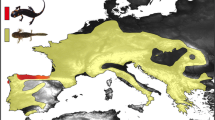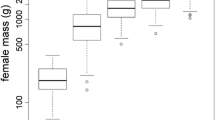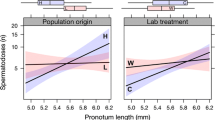Abstract
The theory of resource allocation assumes that a resource not allocated to one function may be reallocated to another. Thus, in hermaphroditic species, an individual that suppresses the use of one sex function may free resources for the other sex function. We determined the relative importance of male copulatory organs in terms of their fraction of the total dry body weight and tested whether in the pulmonate land slug Deroceras laeve (Müller), individuals that lack the male copulatory organs (aphallics) reallocate this resource towards the female structures and/or towards life-history traits. To this end, we raised 13 families under uniparental reproduction and compared growth, length of the juvenile period, number of eggs produced, percentage of hatched eggs and hatching time among a- and euphallics. We also measured the reproductive and sex allocation of all individuals. Six out of 13 families contained no euphallic individuals. In the other seven families, the proportion of euphallic individuals ranged from 0.13 to 0.43. There was an enormous variation in life-history traits and reproductive and sex allocation among individuals, even among individuals of the same family. Allocation to the male function was very low in euphallic slugs (i.e. 1.35% of the total body dry mass and 12.33% of the total reproductive dry mass). Our results did not reveal a reallocation from the lost male function towards the female function, nor towards one of the life-history traits. Finally, we propose a scenario that could explain the maintenance of phally polymorphism in D. laeve.
Similar content being viewed by others
References
Baur B (1990) Egg cannibalism in hatchlings of the land snail Helix pomatia: nutritional advantage may outweight lack of kin recognition. Malacol Rev 23:103–105
Baur B, Chen X (1993) Genital dimorphism in the land snail Chondrina avenacea: frequency of aphally in natural populations and morph-specific allocation to reproductive organs. Veliger 36:252–258
Baur B, Chen X, Baur A (1993) Genital dimorphism in natural populations of the land snail Chondrina clienta and the influence of the environment on its expression. J Zool (Lond) 231:275–284
Bull JJ (1981) Evolution of environmental sex determination from genotypic sex determination Heredity 47:173–184
Charnov EL (1982) The theory of sex allocation. University Press, Princeton, USA
Charnov EL (1996) Sperm competition and sex allocation in simultaneous hermaphrodites. Evol Ecol 10:457–462
Dankowska E (1996) Morphology and life history of Deroceras laeve (Müll.) (Gastropoda: Stylommatophora: Agriolimacidae) in greenhouse conditions. Rocz Nauk Roln Ser E 25:91–95
Doums C, Jarne P (1996) The evolution of phally polymorphism in Bulinus truncatus (Gastropoda, Planorbidae): the cost of male function analysed through life-history traits and sex allocation. Oecologia 106:464–469
Doums C, Perdieu M-A, Jarne P (1998a) Resource allocation and stressful conditions in the aphallic snail Bulinus truncatus. Ecology 79:720–733
Doums C, Viard F, Jarne P (1998b) The evolution of phally polymorphism. Biol J Linn Soc 64:273–296
Foltz DW, Schaitkin BM, Selander RK (1982) Gametic disequilibrium in the self-fertilizing slug Deroceras laeve. Evolution 36:80–85
Greeff JM, Michiels NK (1999) Sperm digestion and reciprocal sperm transfer can drive hermaphrodite sex allocation to equality. Am Nat 153:421–430
Heath DJ (1977) Simultaneous hermaphroditism: costs and benefit. J Theor Biol 61:363–375
Jarne P, Finot L, Bellec C, Delay B (1992) Aphally versus euphally in self-fertile hermaphrodite snails from the species Bulinus truncatus (Pulmonata: Planorbidae). Am Nat 139:424–432
Jordaens K, Pinceel J, Backeljau T (In Press) Life history variation in selfing multilocus genotypes of the land slug Deroceras laeve (Gastropoda, Pulmonata, Agriolimacidae). J Mollusc Stud
Kerney MP, Cameron RAD, Jungbluth JH (1983) Die Landschnecken Nord- und Mitteleuropas. Paul Parey, Berlin, Germany
Lebovitz RM (1998) The inheritance of an embryonic lethal mutation in a self-reproducing terrestrial slug, Deroceras laeve. Malacologia 39:21–27
Littell RC, Stoup WW, Freund RJ (2002) SAS for linear models. SAS Institute Inc., Cary, North Carolina, USA
Locher R, Baur B (2000) Mating frequency and resource allocation to male and female function in the simultaneous hermaphrodite land snail Arianta arbustorum. J Evol Biol 13:607–614
Locher R, Baur B (2002) Nutritional stress changes sex-specific reproductive allocation in the simultaneously hermaphroditic land snail Arianta arbustorum. Funct Ecol 16:623–632
McCracken GF, Selander RK (1980) Self-fertilization and monogenic strains in natural populations of slugs. Proc Natl Acad Sci USA 77:684–688
Nicklas NL, Hoffmann RJ (1981) Apomictic parthenogenesis in a hermaphroditic terrestrial slug, Deroceras laeve (Müller). Biol Bull 160:123–135
Ostrowski M-F, Jarne P, David P (2000) Quantitative genetics of sexual plasticity: the environmental treshold model and genotype-by-environment interaction for phallus development in the snail Bulinus truncatus. Evolution 54:1614–1625
Ostrowski M-F, Jarne P, David P (2003) A phallus for free ? Quantitative genetics of sexual trade-offs in the snail Bulinus truncatus. J Evol Biol 16:7–16
Pokryszko BM (1987) On the aphally in the Vertiginidae (Gastropoda: Pulmonata: Orthurethra). J Conch 32:365–375
Reise H, Hutchinson JMC (2002) Penis-biting slugs: wild claims and confusion. Trends Ecol Evol 17:163
Roff DA (1992) The evolution of life-histories: theory and analysis. Chapman and Hall, London, UK
Rollo CD, Shibata DM (1991) Resilience, robustness, and plasticity in a terrestrial slug, with particular reference to food quality. Can J Zool 69:978–987
SAS Institute (2000) SAS User’s Guide, Release 8.02 ed. SAS Institute Inc, Cary, North Carolina, USA
Schrag SJ, Read AF (1996) Loss of male outcrossing ability in simultaneous hermaphrodites: phylogenetic analyses of pulmonate snails. J Zool (Lond) 238:287–299
Schrag SJ, Rollinson D (1994) Effects of Schistosoma haematobium infection on reproductive success and male outcrossing ability in the simultaneous hermaphrodite Bulinus truncatus (Gastropoda: Planorbidae). Parasitology 108:27–34
Shen J (1995) Cannibalism in the terrestrial slug Deroceras laeve. Nautilus 109:41–42
Shibata DM, Rollo CD (1988) Intraspecific variation in the growth rate of gastropods: five hypotheses. Mem Ent Soc Canada 146:199–213
Sokal RR, Rohlf JF (1995) Biometry: The principles and practise of statistics in biological research. WH Freeman and Company, New York, USA
Tompa AS (1984) Land snails (Stylommatophora). In: Tompa AS, Verdonk NH, van den Biggelaar JAM (eds) The Mollusca, Vol 7, Reproduction. Academic Press, New York, USA, pp 47–140
Van Dooren TJM, Leimar O (2003) The evolution of environmental and genetic sex determination in fluctuating environments. Evolution 57:2667–2677
Verbeke G, Molenberghs G (2000) Linear mixed models for longitudinal data. Springer, New York
Wiktor A (2000) Agriolimacidae (Gastropoda: Pulmonata) – A systematic monograph. Ann Zool 49:347–590
Acknowledgements
We wish to thank Gary Bernon for his help during slug collecting and Natalie Van Houtte for her help during the experiments. The comments of I. Olivieri and of four anonymous referees improved the manuscript considerably. This work was supported by RAFO-project JORDKKP01 of the University of Antwerp and FWO-project 4768 to KJ.
Author information
Authors and Affiliations
Corresponding author
Rights and permissions
About this article
Cite this article
Jordaens, K., Van Dongen, S., Temmerman, K. et al. Resource allocation in a simultaneously hermaphroditic slug with phally polymorphism. Evol Ecol 20, 535–548 (2006). https://doi.org/10.1007/s10682-006-9115-y
Published:
Issue Date:
DOI: https://doi.org/10.1007/s10682-006-9115-y




